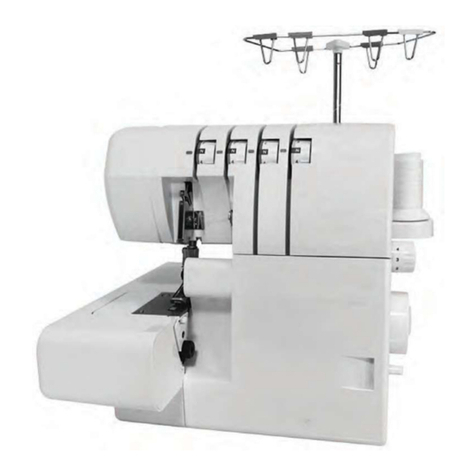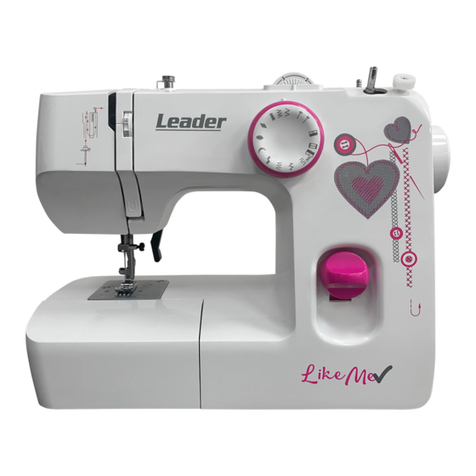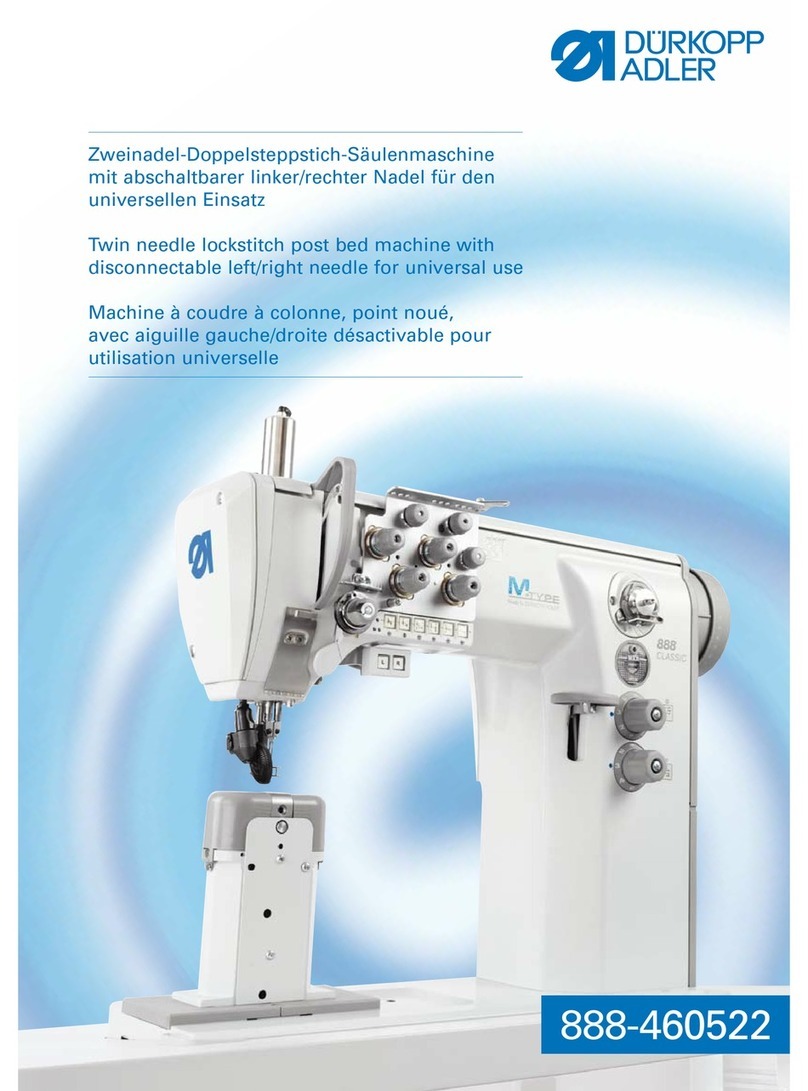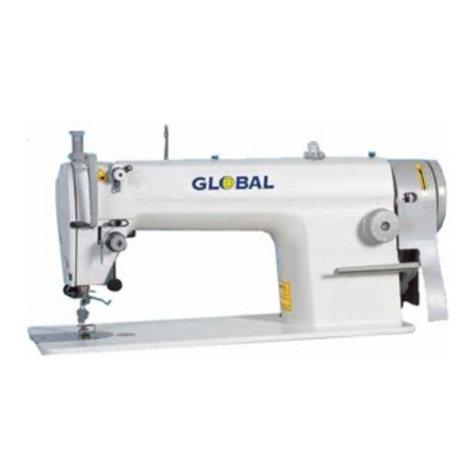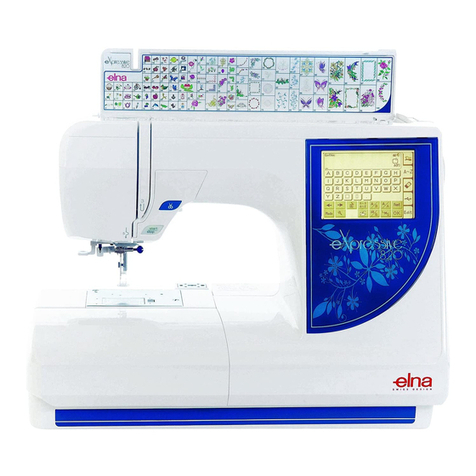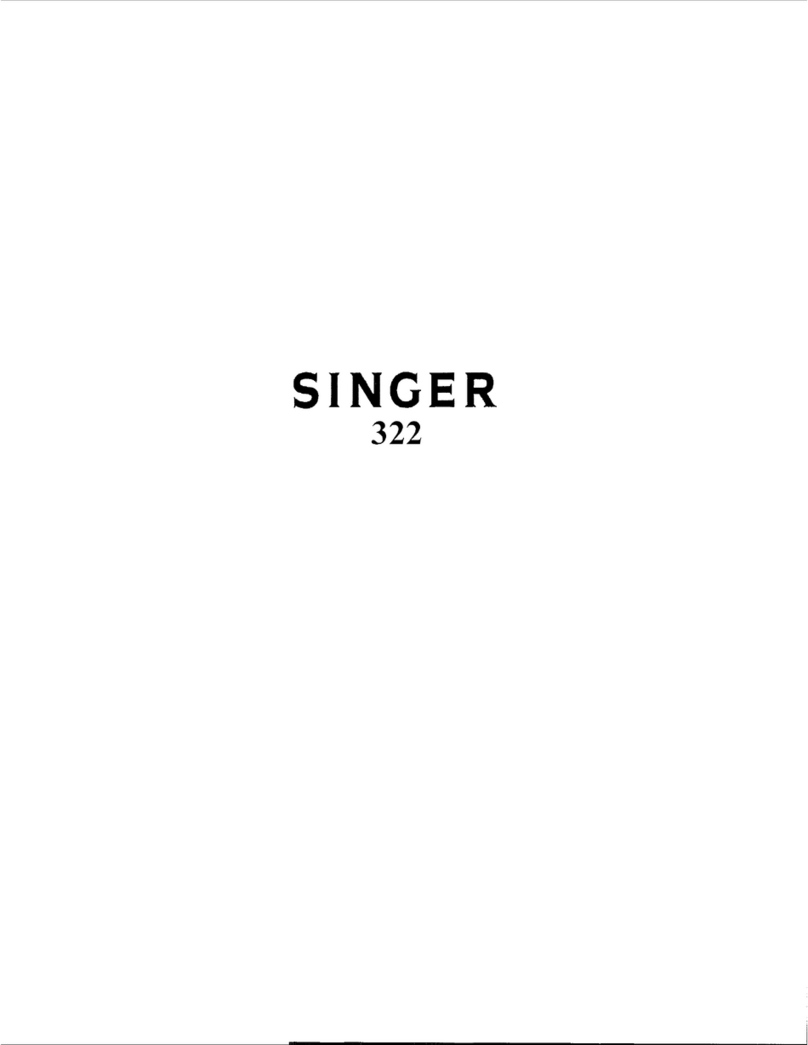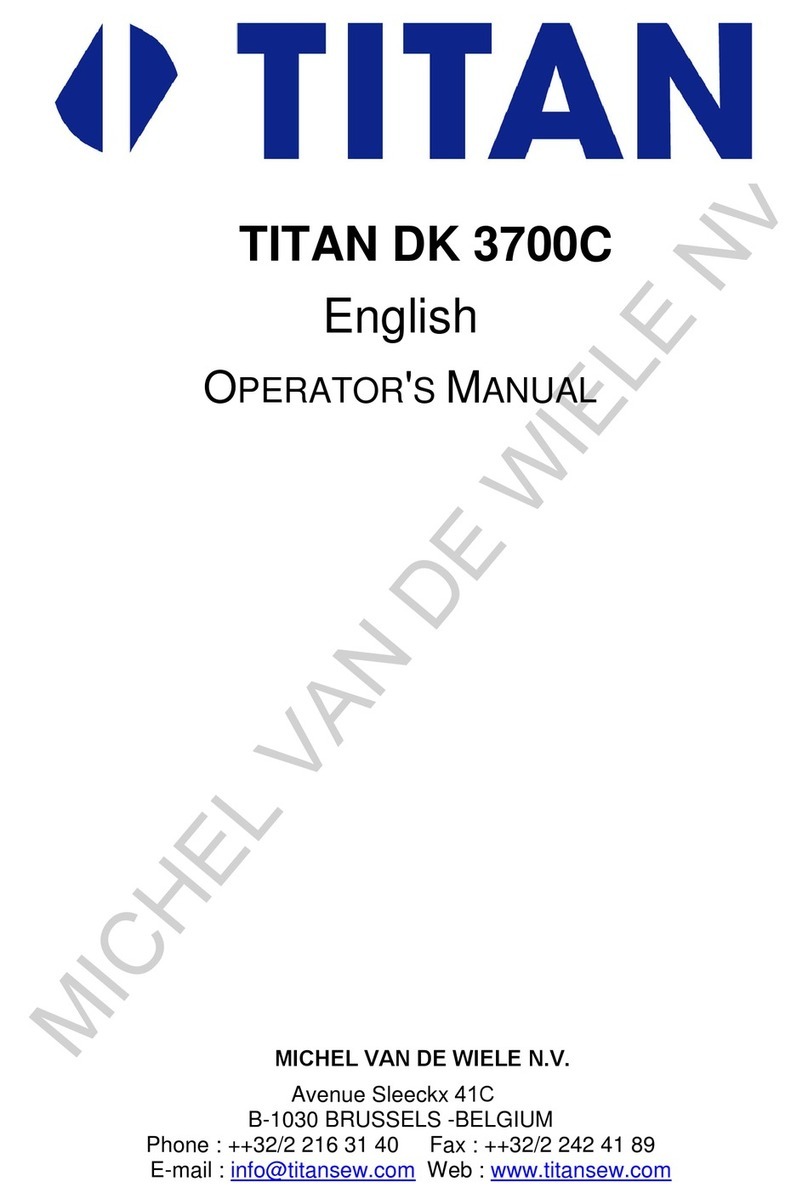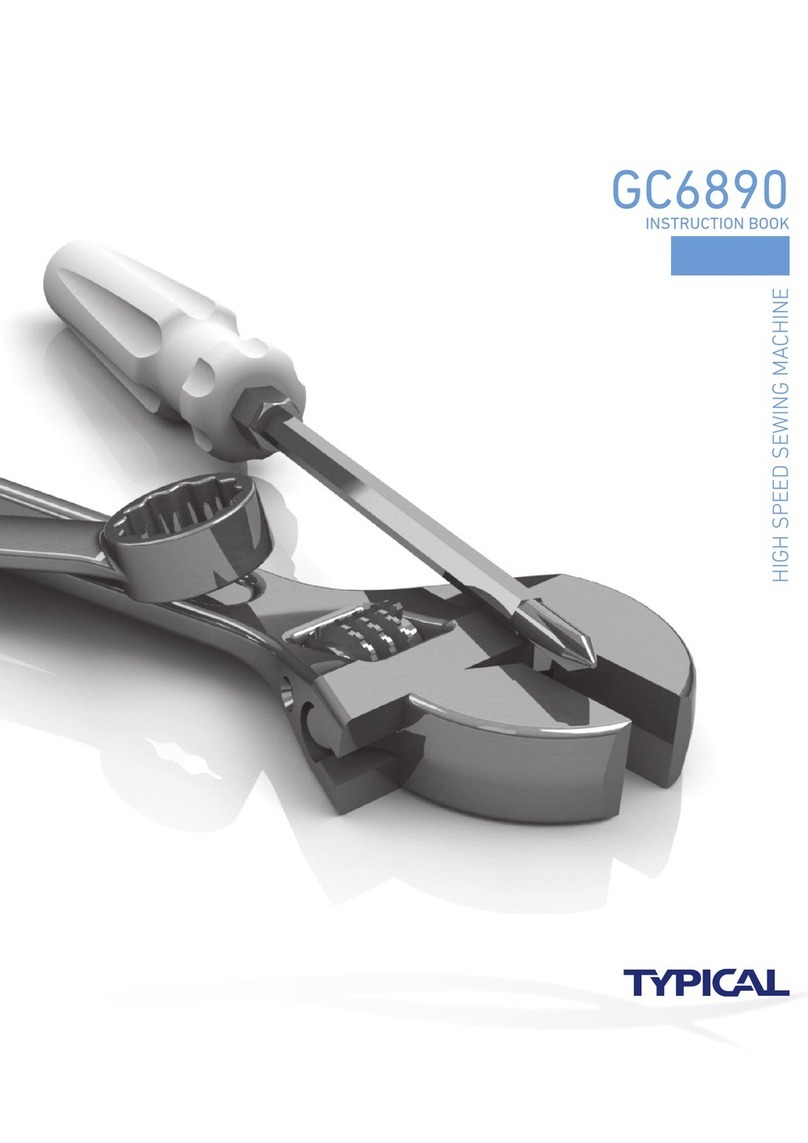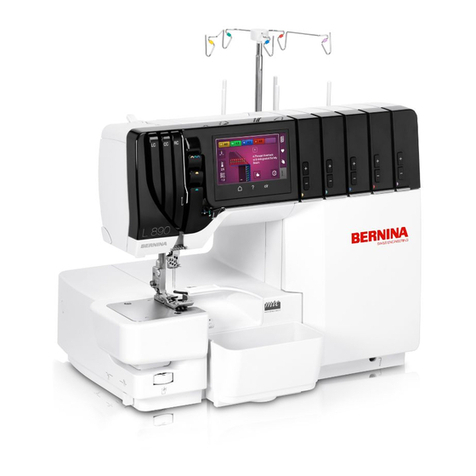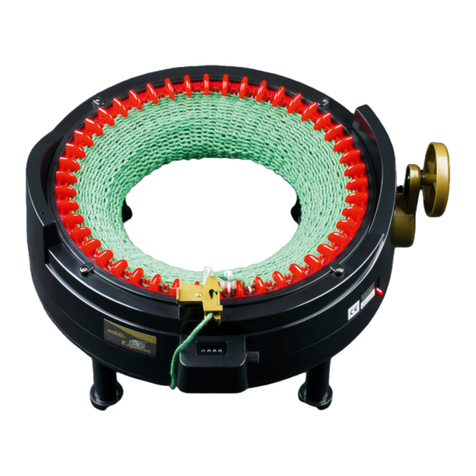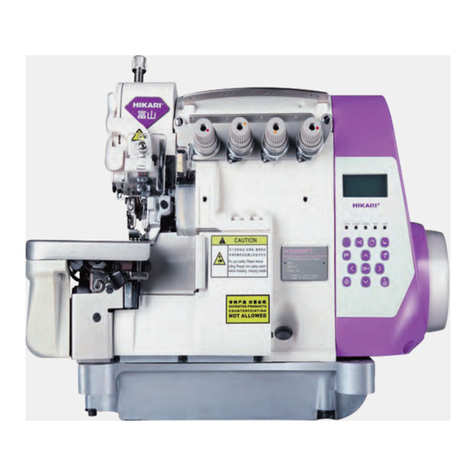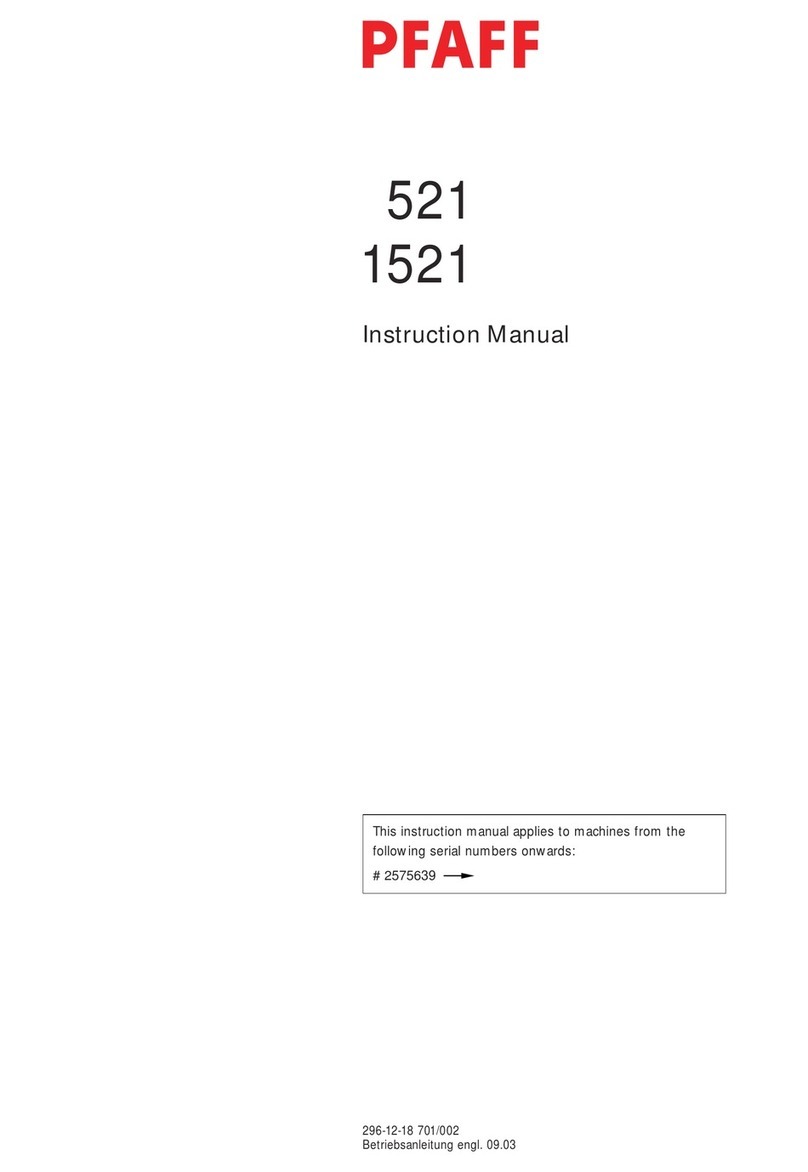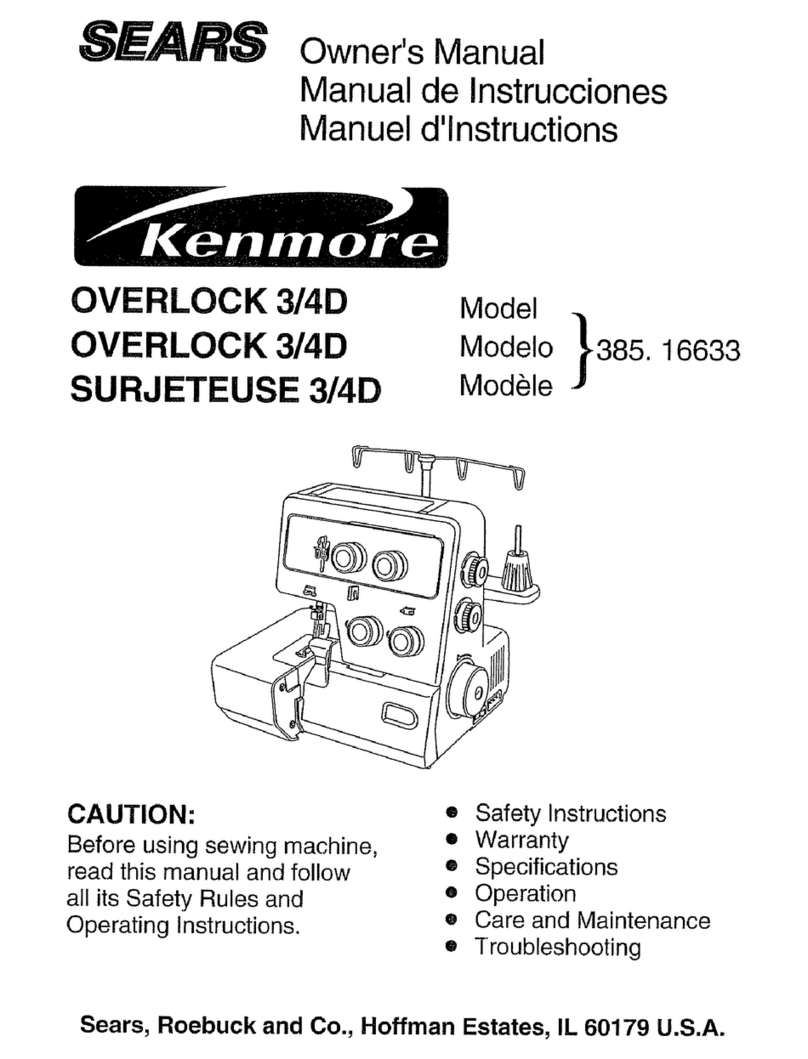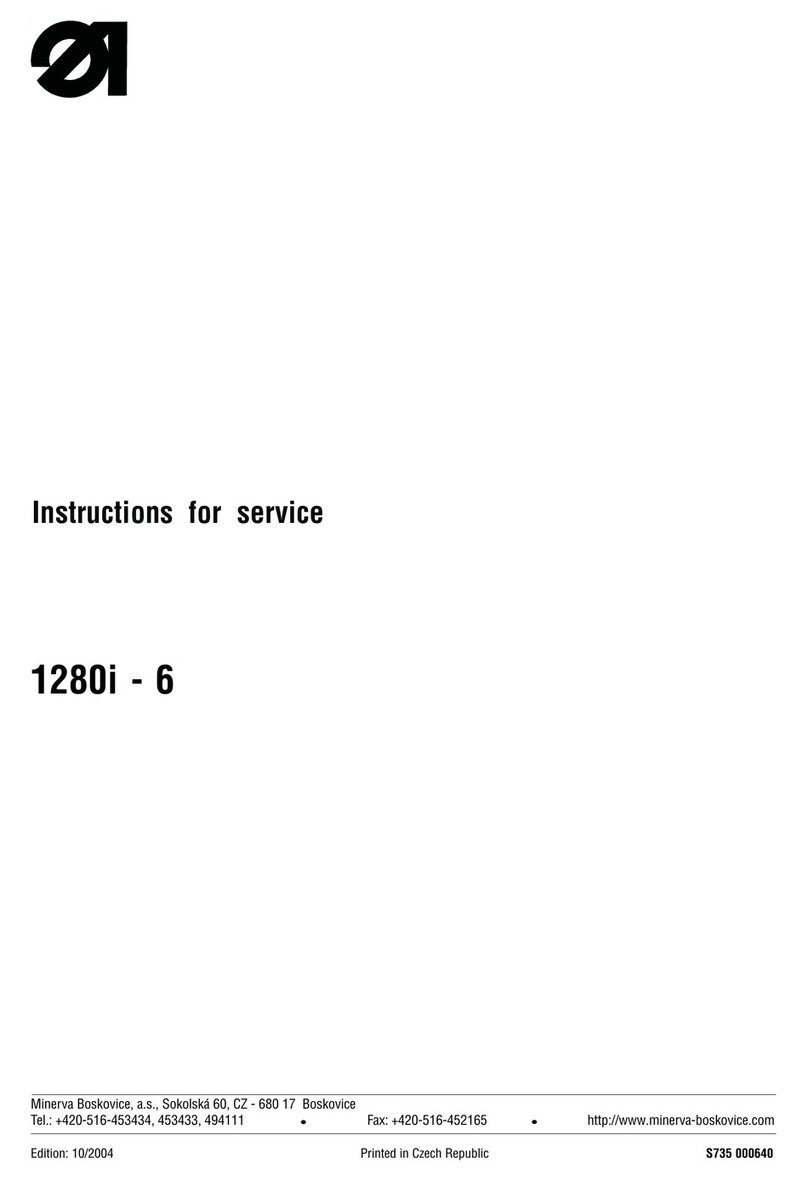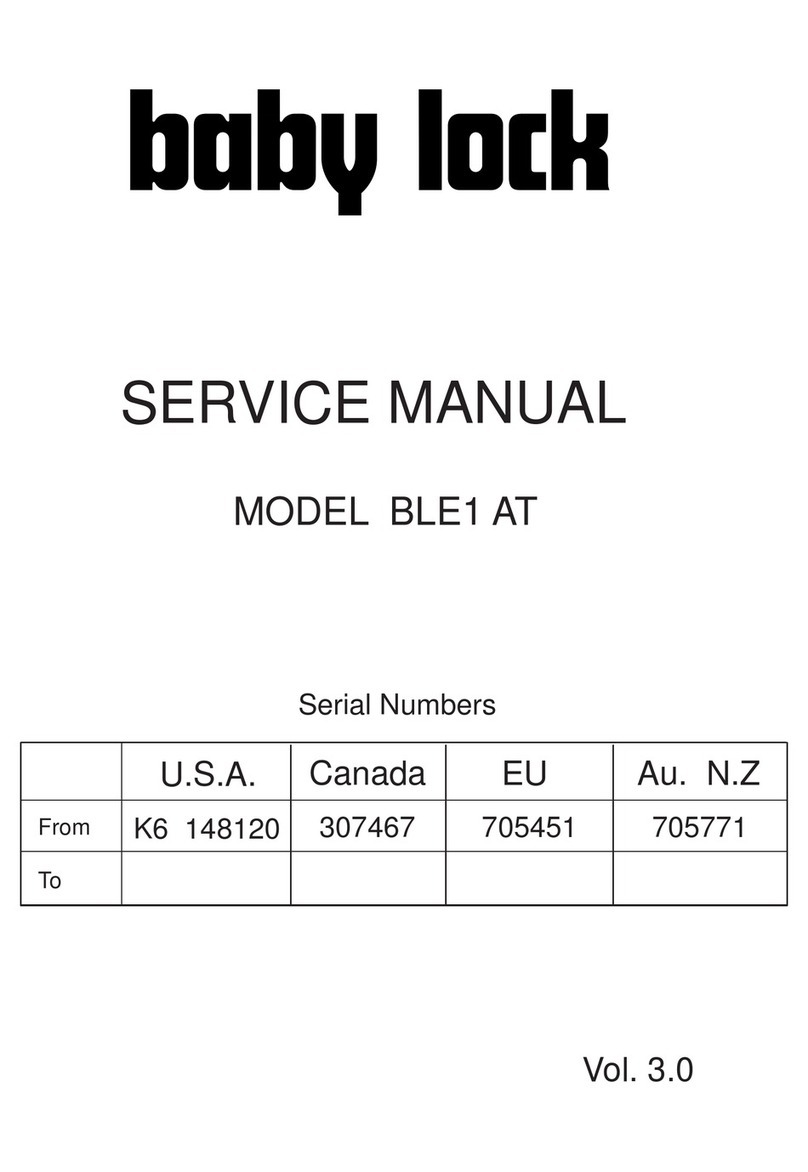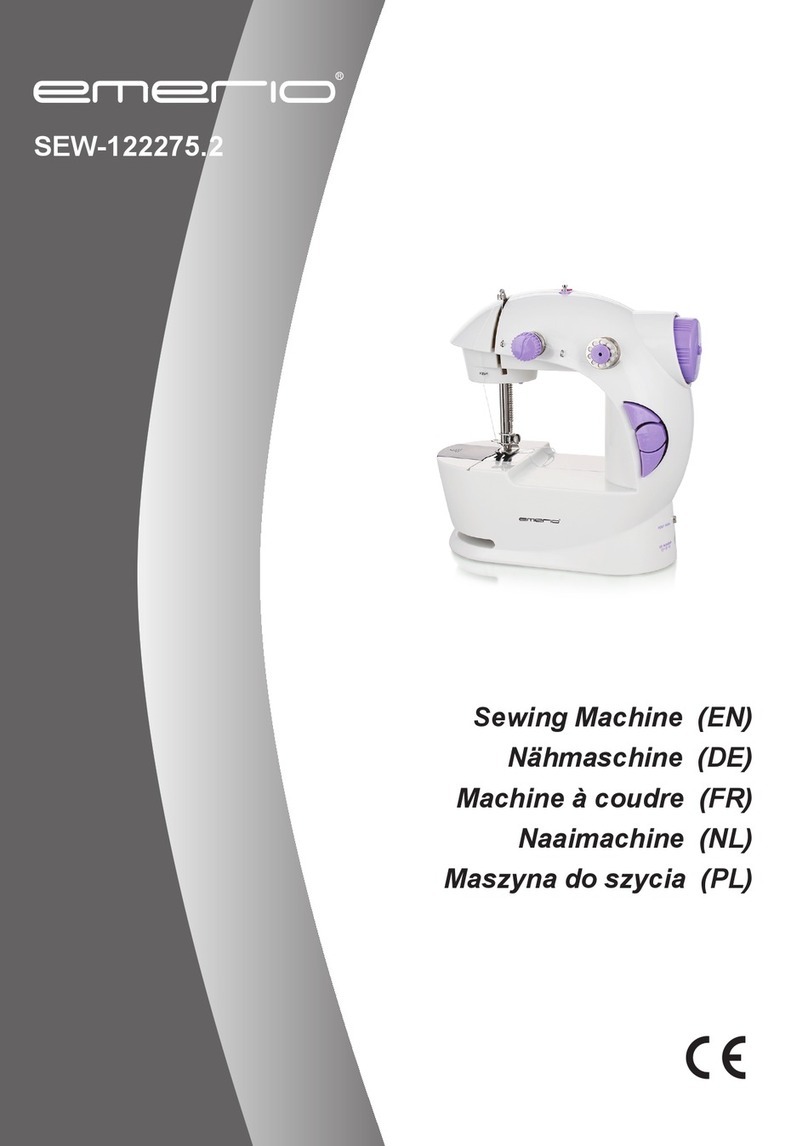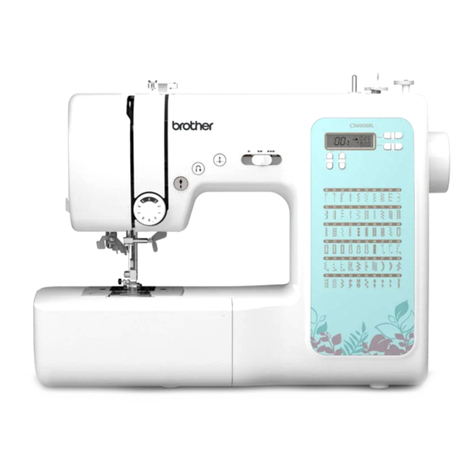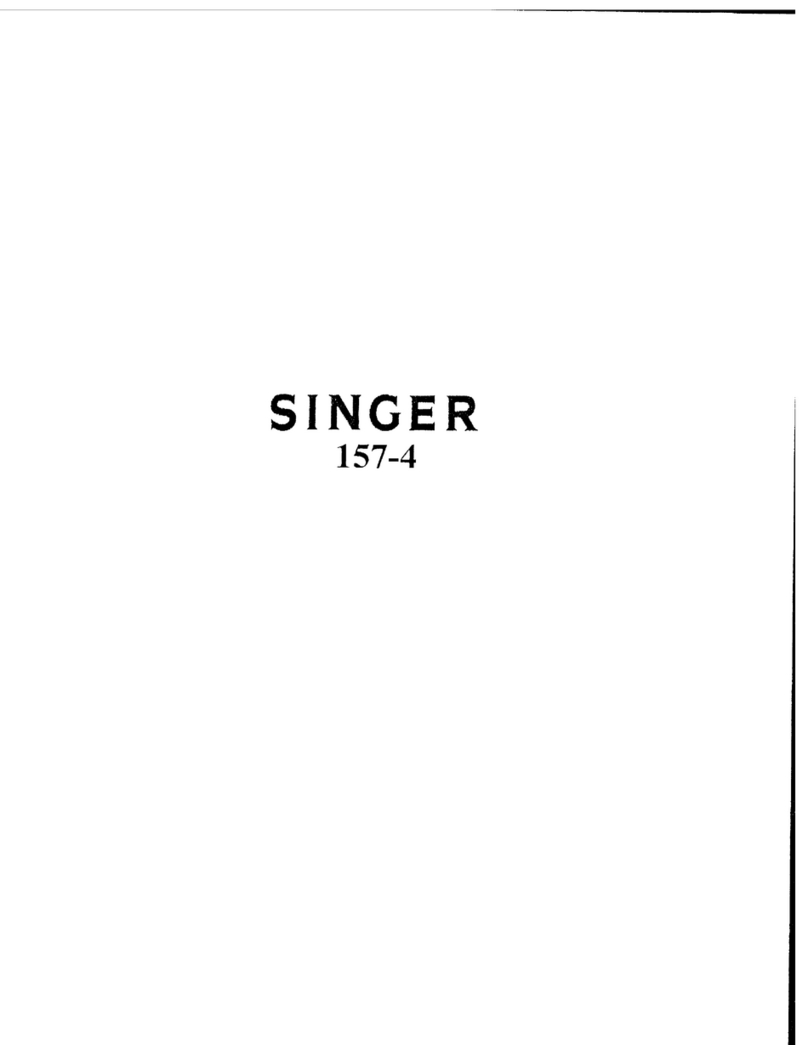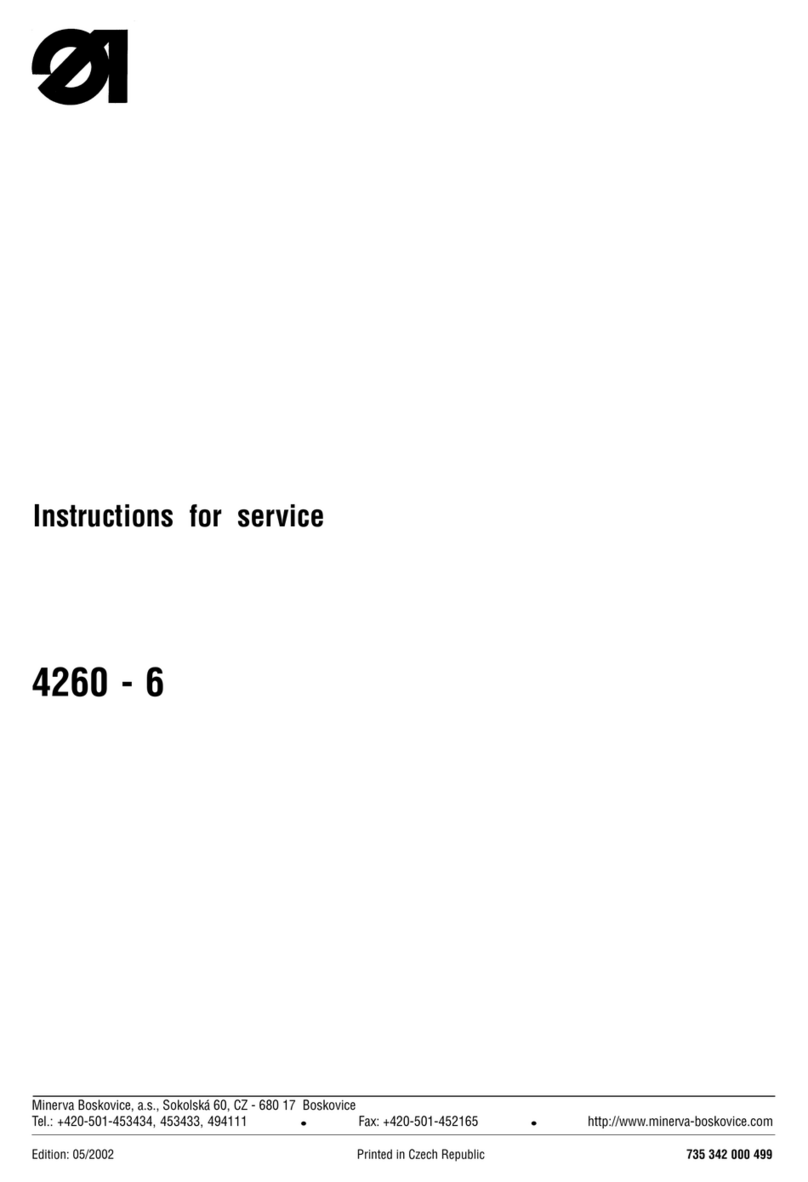Leader VS 325D User manual

Instruction Book
Model: VS 325D
Руководство по эксплуатации
бытового оверлока
Модель: VS 325D

PREFACE
Thank you for your purchase of this sewing machine. This machine intended for household use will provide
you with excellent performance in sewing from light to heavy material (lawn to denim). Please refer to this
booklet for proper use and optimum service. To get the most out of your sewing machine, read the entire
operator’s guide before attempting to operate the machine. Then familiarize yourself with the machine by
following the operator’s guide page by page.
To ensure that you are always provided with the most modern sewing capabilities, the manufacturer reserves
the right to change the appearance, design or accessories of this sewing machine when considered necessary
without notification or obligation.
IMPORTANT SAFETY INSTRUCTIONS
*If the supply cord is damaged, it must be replaced by the manufacturer or its service agent or a similarly
qualified person in order to avoid a hazard.
*The appliance is not intended for use by young children or infirm persons without supervision.
*Young children should be supervised to ensure that they do not play with the appliance.
*Switch off or unplug the machine when leaving it unattended.
*Before servicing the appliance , unplug the machine.
*If the light unit is damaged,it must be replaced by authorized dealer.
1
For European Territories:
This Sewing Machine was tested according to European norms and meets the requirements regarting
electrcal safety radio interference and electromagnetic immunity.
The conformiyt is documented with the mark.

*Be sure that the electrical voltage of the electric outlet (wall receptacle) is the same as the rated voltage of
the motor.
*Use this machine only for its intended use as described in this Operator’s Guide. Use only attachments
recommended by the manufacturer as contained in the Operator’s Guide.
*To disconnect, turn all controls to the off (“0”) position, then remove plug from outlet.
*Disconnect the power line plug from the socket outlet or switch the machine off when making any adjustments
in the needle area, such as threading needle and loopers, changing needle, changing throat plate or
changing presser foot, etc.
*Always unplug the machine from the electrical outlet when removing covers, lubricating, or when making
any other user servicing adjustments mentioned in the Operator’s Guide.
*Do not attempt to adjust the motor belt. Contact your nearest Service Center should any adjustment be
required.
*Do not unplug by pulling on cord. To unplug, grasp the plug, not the cord.
*Handle the foot controller with care and avoid dropping it on the floor. Be sure not to place anything on top
of it.
*Always use the proper throat plate. The wrong plate can cause the needle to break.
*Do not use bent needles.
*When sewing, keep fingers away from all moving parts. Special care is required around the sewing
machine needle.
*Do not pull or push fabric while stitching. It may deflect the needle causing it to break.
*Use only the handle to lift and move the machine.
*Never operate the machine if it has a damaged cord or plug, if it is not working properly, if it has been
dropped or damaged, or dropped into the water. Return the machine to the nearest authorized dealer or
Service Center for examination, repair, electrical, or mechanical adjustment.
*Never operate the machine with any air openings blocked. Keep ventilation openings of the machine and
foot controller free from the accumulation of lint, dust and loose cloth.
*Never drop or insert any object into any opening.
2
When using this machine, basic safety precautions should always be followed including the following.
Read all instructions before using the machine.
DANGER
– To reduce the risk of electric shock:
WARNING
– To reduce the risk of burns, fire, electric shock or injury to persons:
IMPORTANT SAFETY INSTRUCTIONS
*The machine should never be left unattended when plugged in. Always unplug the machine from the
electric outlet immediately after using and before cleaning.

3
* Do not use outdoors.
*Do not operate where aerosol (spray) products are being used or where oxygen is being administered.
*Do not allow to be used as a toy. Close attention is necessary when the machine is used by or near
children.
*Do not expose the machine or machine plastic case to sunlight directly. Also, do not keep it in a very warm
or damp place.
*Do not touch the machine, foot controller and power line cord with wet hand, wet cloth or with anything wet.
*Do not connect power line cord to one of the many cords connected to one power outlet with adapters.
*Use machine on flat and stable table.
*Be sure to close the cylinder cover and looper cover before operating the machine.
*Keep presser foot and needles away from children’s reach.
*Do not dismantle or modify the machine yourself.
*Be sure to turn off the power switch and disconnect the power line plug before caring for your machine as
instructed in the operator’s guide.
*
FOR EUROPEAN AND SIMILAR TERRITORIES:
Machines for Great Britain and some other countries having similar wiring standards are shipped from the
factory without a plug for connection to the mains. The wires in this mains lead are colored in accordance with
the following code.
Blue: neutral (N) Brown: live (L)
As the colors of the wires in the mains lead of this appliance may not correspond with the colored markings
identifying the terminals in your plug, proceed as follows:
The wire which is colored blue must be connected to the terminal which is marked with the letter N or colored
black. The wire which is colored brown must be connected to the terminal which is marked with letter L or
colored red. If a 13 Amp. (BS 1363) plug is used, a 3 Amp. fuse must be fitted, or if any other type of plug is
used, a 5 Amp. fuse must be fitted either in the plug or adaptor or at the distribution board.
Neither cord is to be connected to the earth terminal of a three-pin plug.
SAVE THESE INSTRUCTIONS
Servicing should be performed by an authorized service representative.
This product is not intended for industrial use.
This appliance can be used by children aged from 8 years and above and persons with reduced physical,
sensory or mental capabilities or lack of experience and knowledge if they have been given supervision or
instruction concerning use of the appliance in a safe wayand understand the hazards involved. Children shall
not play with the appliance. Cleaning and user maintenance shall not be made by children without supervision.

4
1. Selection of Stitches ........................................5
2. Handy Reference Chart ..................................6
3. Accessories ...................................................7
4. Needle Information ..........................................7
5. Principal Parts .................................................8
6. How to Open Looper Cover .............................9
7. Principal Parts Behind Looper Cover ..............9
8. Preparation Prior to Sewing ............................9
9. Preparation for Threading ..............................10
•Setting up the thread guide holder ...............10
10. How to Remove and Insert Needles...............11
•To remove needle(s) ....................................11
•To insert needle(s) .......................................11
11. Threading the Machine ..................................12
•Threading diagram .......................................12
•Understanding the color code ......................12
•To thread the machine correctly ...................12
1) Threading the upper looper (Orange) .......12
2) Threading the lower looper (Yellow) ..........14
3) Threading the right needle (Green) ...........16
4) Threading the left needle (Blue) ................18
•Important threading information ...................19
12. How to Change Threads / Tie on Method ......20
13. How to Adjust the Stitch Length ....................21
14. How to Adjust the Seam Width ......................21
•
Width adjustment by changing needle position
...21
•
Width adjustment with adjustment knob
............21
15. How to Adjust the Presser Foot Pressure .....22
16. Differential Feed
(If your machine has this device) ...................23
•Gathered overedge ......................................23
•Stretch overedge .........................................24
17. How to Disengage Movable Upper Knife .......25
19. Free Arm Sewing (Tubular Work) ..................27
20. Standard Overedge and Rolled Hem Stitching .....28
•To sew standard overedge ...........................28
•To sew rolled hem ........................................28
21. Chaining Off and Test Sewing .......................29
25. Stitch Variations and Sewing Techniques ..... 41
•How to sew a flatlock decorative seam ....... 41
•How to sew an overlock blind hem ............ 43
•How to sew pin tucks .................................. 43
•Turning square corners .............................. 44
•Pin placement ............................................. 45
•Securing the thread chain ........................... 45
•How to reinforce a seam ............................. 46
•Braiding by chaining off .............................. 46
26. Machine Maintenance .................................. 47
•Cleaning the machine ................................. 47
•Oiling the machine ...................................... 47
•How to replace the stationary knife ............. 48
27. Troubleshooting Chart .................................. 49
28. Relationship between Cloth, Thread and Needle .... 50
29. Specification ................................................. 51
CONTENTS
Page Page
18. Converting the upper looper into spreader ...........26
24. How to Sew a Rolled Hem ..................................
23. Suggested Tension Setting ................................
2-thread wrapped edge overlock
2-thread standard rolled hem stitching .............
1)
2)
3) 3-Thread Overlock ........................................
4) 3-Thread Flatlock ..........................................
5) 3-Thread Wrapped Edge Overlock ...............
6) 4-Thread Ultra Stretch Mock Safety Stitch ....
1) a. 2-thread wrapped edge overlock ..................
b. 2-thread standard rolled hem stitching .........
22. Starting and Ending Seams ................................ 30
30
30
31
31
32
33
34
35
36
37
38
38
39
39
2) a. 3-thread standard rolled hem stitching .........
b. 3-thread upper looper thread wrapped
rolled hem stitching ...........................................
●To Start a Seam .............................................
●To End a Seam ..............................................


6
Also, for overedging heavyweight fabrics, the seam width can be increased still more by turning the overedge
seam width adjustment knob. (See page 21)
Three - Thread
Overlock 3.0 3.0 3.0
3.0 3.0 3.0
Three - Thread
Flatlock 0.5 5.0 7.0
0.5 5.0 7.0
Three - Thread
Wrapped Edge
Overlock
3.0 1.0 7.0
5.0 0 8.5
Four - Thread Ultra-
Stretch Mock
Safety Stitch 3.0 3.0 3.0 3.0
(504)
(505)
(514)
2. HANDY REFERENCE CHART
The thread tension becomes tighter as the dials are turned to higher numbers. The tension settings shown on
this page as well as throughout the operator’s manual are suggested guides. Adjust thread tensions to suit
the fabric and size of thread used. For best results make tension adjustments in small increments of no
greater than half a number at a time.
Overedge width
Needle used
Needle thread
tension dial
3.5mm
Overedge right needle
Green
5.7mm
Overedge left needle
Blue
36
4.0 2.0
3.5 1.0
0.5 6.0
0.5 5.0


5. PRINCIPAL PARTS
8
1. Thread guides and holder
2. Handle
3. Left needle thread tension dial (blue)
4. Right needle thread tension dial (green)
5. Upper looper thread tension dial (orange)
6. Lower looper thread tension dial (yellow)
7. Throat plate
8. Cloth plate
9. Looper cover
10. Power & light switch
11. Stitch length dial
12. Hand wheel
13. Spool stand
14. Spool holder
15. Spool pin
16. Presser bar lifter
17. Differential feed adjusting lever knob
18. Seam width finger support plate

6. HOW TO OPEN LOOPER COVER
8. PREPARATION PRIOR TO SEWING
9
7. PRINCIPAL PARTS BEHIND
LOOPER COVER
1. Upper looper
2. Movable upper knife
3. Presser foot
4. Stationary lower knife
5. Lower looper
6. Seam width finger knob
7. Seam width adjustment knob
Caution :
Be sure to turn off power switch.
• Push the cover to the right as far as it will go 1 .
• Pull cover down toward you 2 .
Caution:
Be sure looper cover is closed when sewing.
•Connect the controller / electric plug 1 to the
machine receptacle 2 .
• Plug power line 3 into electric outlet 4 .
• Power Switch: Push “ _ ”mark side to turn “ON”.
Push “O” mark side to turn “OFF”.
•To run the machine and control the speed, press
the controller.
•The harder you press, the faster the machine will
sew.
•To stop the machine from sewing, remove your foot
from the controller.
WARNING:
Use only foot controller provided with this
machine.

9 . PREPARATION FOR THREADING
10
•This machine is shipped with the thread guide holder
in the lowered position.
• Fully extend the thread guide holder.
•The two joints on the telescope will click into place
when they are correctly positioned.
• Center the thread guides above the spool pins.
•Place thread over the cone adapters on the spool
pins.
Note: If the machine is threaded, straighten the
threads to prevent tangling.
Setting Up the Thread Guide Holder

11
10. HOW TO REMOVE AND INSERT
NEEDLES
1
2
3
4
Caution :
Be sure to disconnect the machine from the
electric outlet before removing needle(s).
To Remove Needle(s)
To Insert Needle(s)
•Turn the hand wheel toward you until the needle is
at its highest position.
•Loosen, but do not remove the needle set screw
with the small screwdriver.
1. Left needle set screw
2. Right needle set screw
3. Left needle
4. Right needle
• Remove the needle(s).
Caution :
Be sure to disconnect the machine from the
electric outlet before replacing needle(s).
• Hold the needle with the flat surface to the back.
•Insert the needle into the needle clamp as far as it
will go.
• Securely tighten the needle set screw.
Note: *Refer to page 7 for additional needle
information.
*Remove the cloth plate if you find it difficult
to remove and replace the needle.
Flat surface to the rear

12
Threading Diagram
Understanding the Color Code
To Thread The Machine Correctly
11. THREADING THE MACHINE
•A color coded threading diagram is located inside
the looper cover for quick reference.
•Thread the machine in the order 1 to 4 as shown.
Orange
Yellow
Green
Blue
1. Upper looper thread ...........
2. Lower looper thread ...........
3. Right needle thread ............
4. Left needle thread ..............
Caution :
Be sure to turn off power switch.
1) Threading the Upper Looper (Orange)
• Thread the upper looper as indicated 1 ~ 8 .
•Pass thread from back to the front through the
thread guide 1 .
1
3
4
2

13
•Thread the top cover thread
guide by pulling the thread
downward until it slips
under thread guide 2 .
• While holding thread with finger, pass it between
the tension discs and pull thread down to make
certain it is properly located in between the
tension discs 3 .
•Thread the looper area ofthe machine following the
orange color coded thread guides ( 4 ~ 7 ).
•Thread the hole in the upper looper from front to
back 8 .
Note: Use of tweezers provided in the accessory
set to aid in threading the looper.
• Pull about 10cm (4 inches) of thread through the
looper and place to the back of the throat plate.
4
5
6
7
8
2

14
2) Threading the Lower Looper (Yellow)
• Thread the lower looper as indicated 1 ~ 9 .
•Pass thread from back to the front through the
thread guide 1 .
•Thread the top cover thread
guide by pulling the thread
downward until it slips under
thread guide 2 .
•While holding thread with finger, pass it between
the tension discs and pull thread down to make
certain it is properly located in between the
tension discs 3 .
2

15
•Turn the hand wheel toward you until the lower
looper is at the far right.
•Thread the looper area of the machine following
the yellow color coded thread guides 4 ~ 7 .
Note: Use the tweezers provided in the accessory
set to aid in threading the looper.
•Grasp the thread with the tweezers 4 cm (1-1/2
inches) from thread guide 7.
•Place the thread with the point of the tweezers
slightly under and to the left of threading guide 8.
• Pull the thread up and into thread guide 8.
•Pass the thread behind and over the top end of
left looper 9-A.
•Then pull it downward gently so that it will slip
into the slot in the looper 9-B.
• Pick up the thread and pass it through the hole in
the end of the looper 10 .
Note : Use the tweezers provided in the accessory
set to aid in threading the looper.
•The thread should be positioned in the groove of
the lower looper.
•Pull about 10cm (4 inches) of thread through the
looper and place it over the top of the upper
looper and to the back of the throat plate.
4 cm
(1-1/2")
7
8
9 - B 9 - A

16
3) Threading the Right Needle (Green)
• Thread the right needle as indicated 1 ~ 8 .
•Pass thread from back to the front through the
thread guide 1 .
•Thread the top cover thread
guide by pulling the thread
downward until it slips under
thread guide 2.
•While holding thread with finger, pass it between
the tension discs and pull thread down to make
certain it is properly located in between the
tension discs 3 .
2

17
• Continue to thread points 4 ~ 7 .
Note: Be sure to pass the thread through upper
thread path of the thread guide 6 .
• Thread the eye of the right needle 8 .
Note: Use of tweezers in the accessory set will
make needle eye threading easy.
• Draw about 10cm (4 inches) of thread through
needle eye to hang free.
• Place the thread to the back, under the presser
foot.

18
4) Threading the Left Needle (Blue)
• Thread the left needle as indicated 1 ~ 7 .
•Pass thread from back to the front through the
thread guide 1 .
•Thread the top cover thread
guide by pulling the thread
downward until it slips under
thread guide 2.
•While holding thread with finger, pass it between
the tension discs and pull thread down to make
certain it is properly located in between the
tension discs 3 .
2

19
• Continue to thread points 4 ~ 6 .
Note: Be sure to pass the thread through lower
thread path of the thread guide 5 .
• Thread the eye of the left needle 7 .
Note: Use of tweezers in the accessory set will
make needle eye threading easy.
• Draw about 10cm (4 inches) of thread through
needle eye to hang free.
• Place the thread to the back, under the presser
foot.
• Always thread the needle(s) last to prevent
misthreading the lower looper.
• If the lower looper should come unthreaded;
1) Unthread the needle(s)
2) Thread the lower looper
3) Thread the needle(s)
Important Threading Information
Wrong
View
Correct
View
Table of contents
Languages:
Other Leader Sewing Machine manuals
